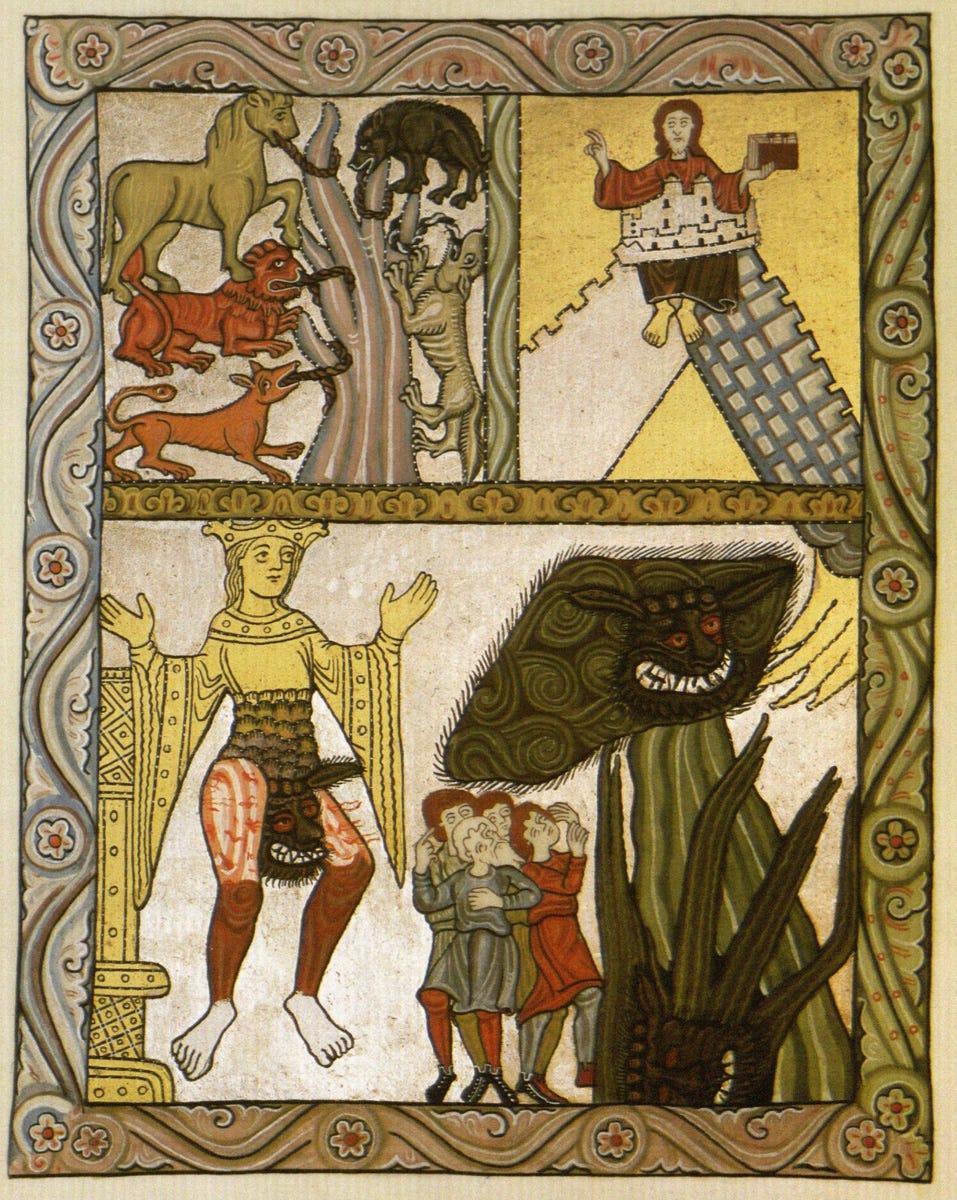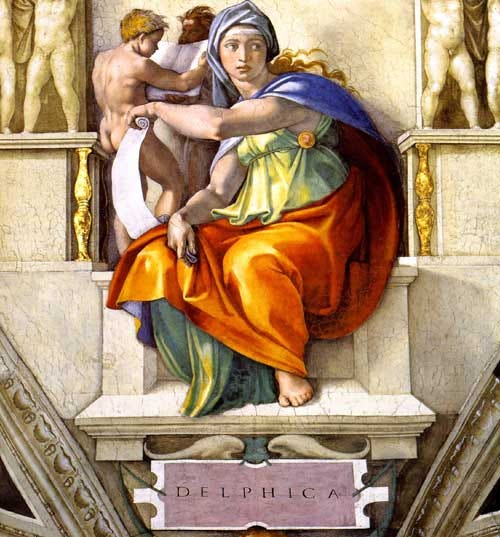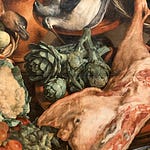It’s a cold winter’s night in Barcelona. In the darkened church a single tabor beats out a slow rhythm, soaked up by the people who have crowded the aisles and nave to hear about the end of their world. A pipe howls. The sun will lose its light showing itself dark and veiled, sings a woman stood at the chancel, draped in a white smock over a dark blue gown whose capacious sleeves almost touch the cold stone slabs beneath our feet. I crane my neck around the octagonal pillars, some 12 or 15 feet thick, to see her picked out by the candlelight. She’s wearing a white wimple, in the centre of which is a jewel. In her extended hands she brandishes a sword, its tip pointed towards heaven. Around her a small choir of 8 or 10 singers are dressed entirely in black. The shuffling and murmuring of the crowd hushed as soon as she entered the nave from the rear of the church. Now she exists as the sole object of attention, thousands of eyes and souls all peering towards her. It’s late, and the world outside is quiet. Tomorrow would be Christmas Day. The moon will give no light and the whole world will be sorrow, she warns us. Fire will come from heaven. The rivers and fountains will burn. The reign of the antichrist will be short, but nonetheless catastrophic. We will lose martyrs and will visit hell. This is the end of the world.
Almost as solemnly as she arrived, she leaves, accompanied again only by the drum and the wailing drone of a Catalan bagpipe, known as a sac de gemecs — quite literally, a bag of moans. We shuffle out, having survived another warning, the warning itself a prayer to the Virgin Mary to deliver Christ, to deliver us. The basilica of Santa Maria del Mar is 700 years old, a small masterpiece of Catalan Gothic architecture, but the song is older; it had already been sung in this region for probably 400 years when the foundation stone was laid. It is said to have been sung in a handful of churches across Catalonia, the Balearics and Sardinia every Christmas Eve for a millennium. The name for this liturgical drama is El Cant de la Sibil·la, The Song of the Sybil, and now it’s something I attend every Christmas, a feast that, to my mind, requires a dark lining to add depth to the celebrations.
The antichrist, as depicted in the Rupertsberg codex of Hildegard von Bingen’s Scivias
I have an interest in the prophecies of the end of the world, and especially those of the sibyls, who first appear in the cultures of ancient Greece as women whose prophetic visions were of the gods, channelled through these priestesses. The role was formalised, passed down through successors, and the most famous today is no doubt the sibyl who tended the Oracle at Delphi — remembered in a Western European tradition thanks to the later belief that she prophesied the birth of Christ. A few years ago I published a novel called Unknown Language, based on the mystical visions and cosmology of Hildegard von Bingen, a twelfth century German abbess whose extensive writings on her experiences led to her being known as the Sibyl of the Rhine. In my book the protagonist lives through the end of the world that Hildegard prophesied, and in some form survives it. It is this, in fact, that interests me most: not merely the apocalypse, but those who survive the apocalypse.
Hildegard’s visions of the end of the world weren’t cut from whole cloth. A European imaginary of the apocalypse is something of a tradition, a visual world full of allegories and images that we have inherited from people of the past, and while the meanings and context have changed, the form of the terror is something so deeply ingrained in a European psyche that its descriptive powers seem to still resonate. Our understanding of it as a physical catastrophe, one marked by burning rivers and mountains laid low, for example, is a gift handed down to us by the nightmares of earlier generations. It’s a vision of climate catastrophe, malign governance, sickness and eventual redemption that we amend and alter, but it’s an intangible inheritance of fear nonetheless. Much of the visual and theological imagery for this type of apocalypse comes from Jewish and early Christian sources. These were people living under Roman occupation and in the idea of a final judgement they found a recompense for present sufferings that seemed not just deeply unjust, but almost unending. And, truly, the present suffering didn’t, doesn’t, end. The visions resonated as they spread through the Balkans, Eastern Europe, and finally to this little crescent of the Mediterranean, precisely because they were the fears of everyday life. To take some common interpretations of the four horsemen featured in the Book of Revelations; famine, war, pestilence, social breakdown, the collapse of empires, and death. These were the everyday fears of everyday Christians for millenia. Were we to be paying attention, they still would be.
There is a preterist interpretation of the Book of Revelation, arguing that it was written not as a prophecy of events to come, but as a description of the trials already faced by the early Christians in the first century. Its author was John of Patmos, an elusive historical figure who we know only through his book, but who quite credibly claimed to be living in exile on the island of Patmos, where he had his visions, due to his being persecuted by the Roman authorities.
The Delphic Sibyl, as represented by Michelangelo on the ceiling of the Sistine Chapel
It’s hardly a surprise he was persecuted. The Romans feared prophecy, and especially prophecy with political implications, as only true believers can. They themselves had their own Sibylline oracles: not living prophetesses, but books, the Libri Sibyllini, which they believed had been given to the last king of Rome before the formation of the Republic by a Greek sibyl, and contained oracular visions that the Romans consulted for centuries not just to understand what they were undergoing, but what rites and rituals to perform to assuage the gods and prevent catastrophe. Interestingly, they were one of the reasons why the Roman pantheon of gods came to mirror the Greek. The books were written in Greek hexameter, and the plasticity with which they could be interpreted, especially politically, would eventually be their downfall. They were destroyed around the end of the 4th century, just as the Empire was splitting between Rome and Constantinople.
Yet the figure of the sibyl survived this end of her world. In the decades and centuries that followed her excision from Roman religion and politics, she re-emerged in a strange, almost parodical form in the books of Hellenistic Jewish and early Christian writers in the eastern Empire, who saw in her cultural legacy and form a mouth to utter new prophecies (indeed, one Greek writer, Celsus, described Christians as “sibyl-mongers” due to their tendency to prophecy). A whole series of books written at this time, aping the Greek hexameter of the Libri Sibyllini came to be known as the Oracula Sibyllina - the Sibylline Oracles. With a rich eschatological imagery describing contemporary events within the context of an unfolding, unravelling world, soon heading for judgement, these books would slowly creep up into Europe where they would foment panic, insurrection and crusades for a thousand years to come, influencing the end-of-the-worldview of not just Hildegard, but also El Cant de la Sibil·la, and many more. Peasants, priests and princes: few were immune from the terrifying charm of the end.
But it was another churchman, a bishop from Hippo named Augustine, who saw in the collapsing Western Roman Empire his own moment to fundamentally change Christian relationships with prophecy. Next week for paid subscribers I’ll talk more about St Augustine’s vision of the end of the world, the influence of the Sibylline Oracles on mediaeval Europe, and about our contemporary visions of the last unravelling of existence.
‘Utopian Drivel’ is written by me, Huw Lemmey. If you’re a paid subscriber, thank you so much for your support. Please do forward this to anyone who might enjoy it.
If you aren’t a paid subscriber, please consider subscribing; paid subscribers also help support pieces for free subscribers! You also get access to the entire archive of 100+ essays, including posts such as this piece on the idea of a gay audience, this essay on the quality of phone screentime, , this essay on depression through a mirror, darkly, and this report on watching the Queen’s funeral at a gay sauna. Free subscribers get occasional posts, like this guided walking tour around London’s world of queer espionage, or this double-header on the Gay History of Private Eye magazine.













Share this post